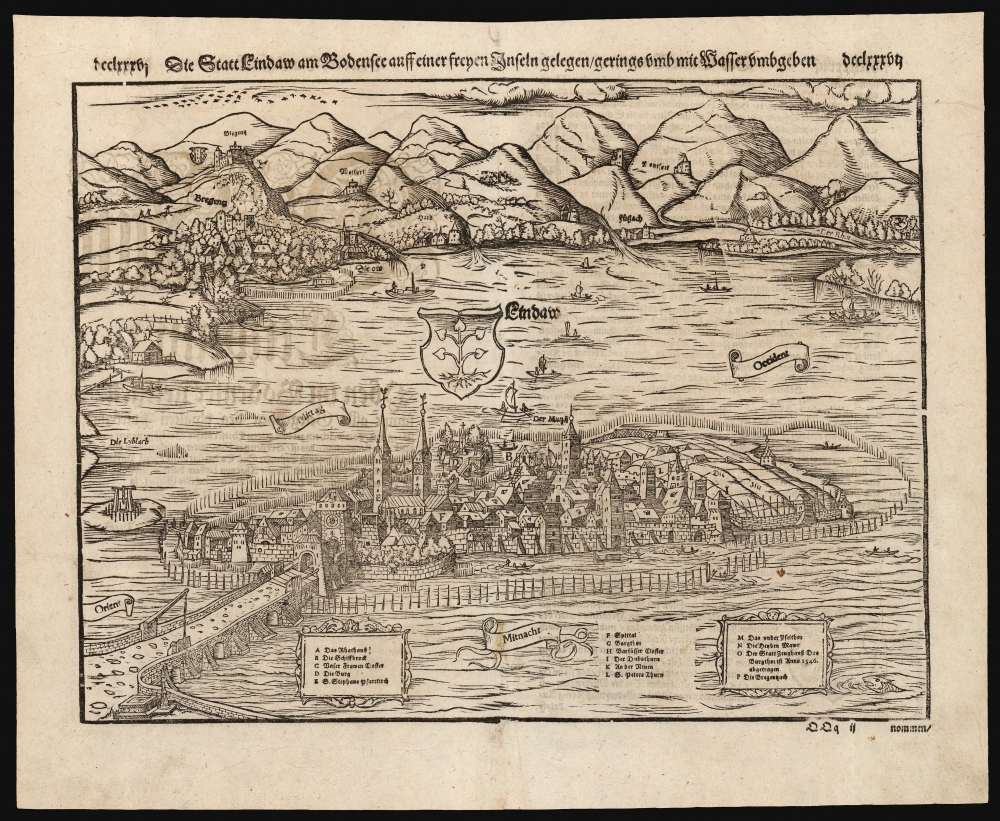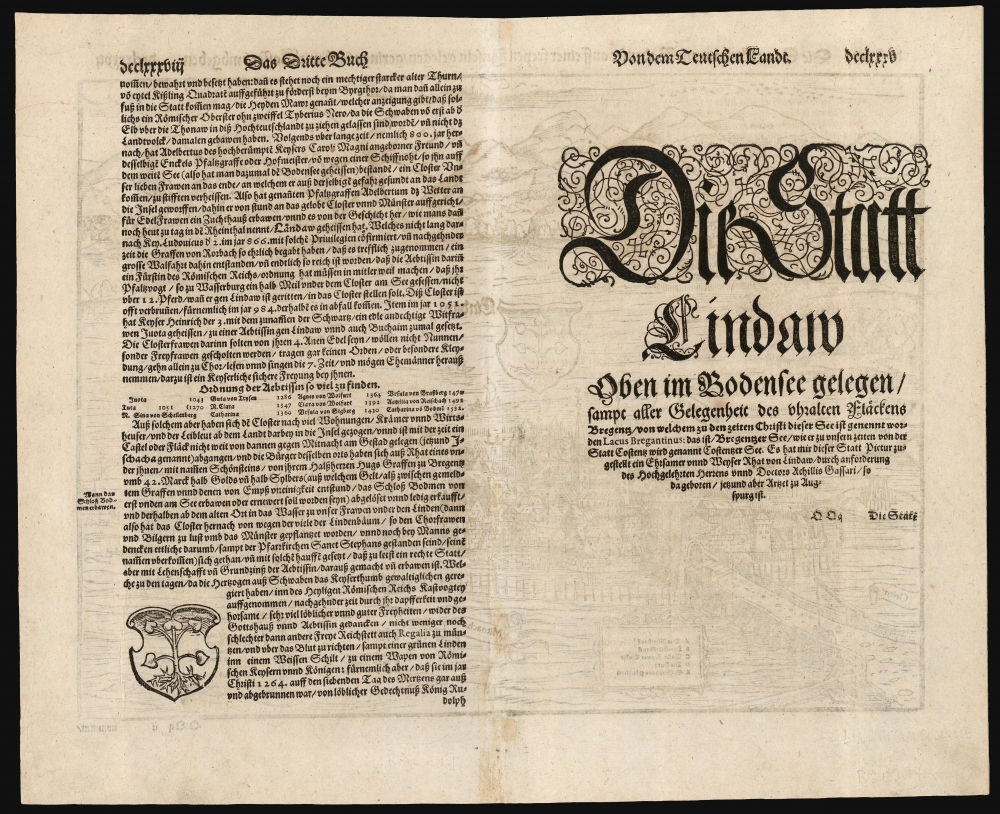This item has been sold, but you can get on the Waitlist to be notified if another example becomes available, or purchase a digital scan.
1598 Münster View of Lindau am Bodensee, Germany
Lindau-munster-1550
Title
1550 (undated) 11 x 14 in (27.94 x 35.56 cm)
Description
A Closer Look
The view, oriented to the southwest, displays the walled island-city connected to land via a causeway, on the northeast shore of Lake Constance (Bodensee). In the background, the south shore of the lake is depicted with several of its cities and towns, including Bregenz and its castle, Wolfurt, Hard, and Fussach - the Alps tower in the distance. In the upper right, the Rhine flows into Lake Constance. Near the center is a coat of arms with Lindau's linden-tree sigil.The city's famous architecture is visible and recognizable. For example, the city hall's stepped façade is easily spotted. Likewise, the tower of the Mangenturm can be seen. In all, fifteen specific edifices are named in a letter key on the view. The waters of Lake Constance are filled with boats, whilst a sea monster prowls alarmingly close to the city.
Adding to the Cosmographia
From its first printings in 1544, Münster's Cosmographia was notable for maps and views depicting their subjects for the first time in print. In subsequent editions, Münster labored to build the work by ordering improved city views and additional decorative woodcuts. 1550 saw the addition of many maps and views to the body of the work, this among them. Münster's spur to do so was the 1548 publication of Johannes Stumpf's magnificently illustrated history of Switzerland, whose woodcut maps and views outstripped those in Cosmographia both in quality and number. Münster knew he had to improve, and commissioned many of the woodcuts that would make his work the most popular.Publication History and Census
This woodcut was executed by the formschneider Jacob Clauser, who produced many of Munster's woodcuts. It first appeared in the 1550 Latin edition of Cosmographia, and was included in all subsequent editions. There are many changes in state to the print, mainly owing to changes in the letterpress fit into the block. The present example conforms typographically to the 1598 German-text edition of Cosmographia. Eight separate examples are listed in OCLC, but the work appears on the market from time to time.CartographerS
Sebastian Münster (January 20, 1488 - May 26, 1552), was a German cartographer, cosmographer, Hebrew scholar and humanist. He was born at Ingelheim near Mainz, the son of Andreas Munster. He completed his studies at the Eberhard-Karls-Universität Tübingen in 1518, after which he was appointed to the University of Basel in 1527. As Professor of Hebrew, he edited the Hebrew Bible, accompanied by a Latin translation. In 1540 he published a Latin edition of Ptolemy's Geographia, which presented the ancient cartographer's 2nd century geographical data supplemented systematically with maps of the modern world. This was followed by what can be considered his principal work, the Cosmographia. First issued in 1544, this was the earliest German description of the modern world. It would become the go-to book for any literate layperson who wished to know about anywhere that was further than a day's journey from home. In preparation for his work on Cosmographia, Münster reached out to humanists around Europe and especially within the Holy Roman Empire, enlisting colleagues to provide him with up-to-date maps and views of their countries and cities, with the result that the book contains a disproportionate number of maps providing the first modern depictions of the areas they depict. Münster, as a religious man, was not producing a travel guide. Just as his work in ancient languages was intended to provide his students with as direct a connection as possible to scriptural revelation, his object in producing Cosmographia was to provide the reader with a description of all of creation: a further means of gaining revelation. The book, unsurprisingly, proved popular and was reissued in numerous editions and languages including Latin, French, Italian, and Czech. The last German edition was published in 1628, long after Münster's death of the plague in 1552. Cosmographia was one of the most successful and popular books of the 16th century, passing through 24 editions between 1544 and 1628. This success was due in part to its fascinating woodcuts (some by Hans Holbein the Younger, Urs Graf, Hans Rudolph Manuel Deutsch, and David Kandel). Münster's work was highly influential in reviving classical geography in 16th century Europe, and providing the intellectual foundations for the production of later compilations of cartographic work, such as Ortelius' Theatrum Orbis Terrarum Münster's output includes a small format 1536 map of Europe; the 1532 Grynaeus map of the world is also attributed to him. His non-geographical output includes Dictionarium trilingue in Latin, Greek, and Hebrew, and his 1537 Hebrew Gospel of Matthew. Most of Munster's work was published by his stepson, Heinrich Petri (Henricus Petrus), and his son Sebastian Henric Petri. More by this mapmaker...
Heinrich Petri (1508 - 1579) and his son Sebastian Henric Petri (1545 – 1627) were printers based in Basel, Switzerland. Heinrich was the son of the printer Adam Petri and Anna Selber. After Adam died in 1527, Anna married the humanist and geographer Sebastian Münster - one of Adam's collaborators. Sebastian contracted his stepson, Henricus Petri (Petrus), to print editions of his wildly popular Cosmographia. Later Petri, brought his son, Sebastian Henric Petri, into the family business. Their firm was known as the Officina Henricpetrina. In addition to the Cosmographia, they also published a number of other seminal works including the 1566 second edition of Nicolaus Copernicus's De Revolutionibus Orbium Coelestium and Georg Joachim Rheticus's Narratio. Learn More...
Achilles Pirmin Gasser (November 3, 1505 - December 4, 1577) was a German doctor and humanist scholar whose work spanned the fields of astronomy, astrology, history, and geography; he was recognized by his colleagues as a talented cosmographer. He was born in Lindau am Bodensee. He was broadly traveled: he studied in Sélestat under Johgannes Sapidus, and attended university in France, Germany and Italy. He was among the first humanists to respond enthusiastically to Sebastian Münster's 1528 appeal for views, maps, and descriptions of Germany. Münster and Gasser may have met in Basel as early as 1529; Gasser named Münster in his 1531 world chronicle, among luminaries such as Apianus and oronce Fine. Indeed, Gasser and Münster shared the same publisher, Heinrich Petri. When Münster expanded his Cosmographia after 1548 he included at least one view provided by Gasser, that of his birthplace Lindau; he contributed broadly to Münster's historical descriptions of places with which he had direct knowledge, namely Lindau, Feldkirch, Chur, and Augsburg. In addition to his views and descriptions, Gasser also assisted in raising funds for Münster's monumental project. Learn More...
Jacob Clauser (1520?-1579?) was a Swiss draftsman, painter and designer for woodcuts. Many of his illustrations appeared in Münster's 'Cosmographia'. Born in Zurich, he was active in the Upper Rhine and Lake Constance region. Learn More...
Source
Munster's methodology in Cosmographia is notable in particular for his dedication to providing his readers with direct access to firsthand reports of his subjects wherever possible. Many of the maps were the result of his own surveys; others, the fruit of an indefatigable letter writing campaign to scholars, churchmen and princes throughout Europe, amicably badgering them for maps, views, and detailed descriptions of their lands. For lands further afield than his letters could reach, Munster relied on the best that the authorities of northern European scholarship could offer: he was well familiar with the work of Waldseemuller and other geographers of the early 16th century, and was well connected with the best geographers of his own generation. A disproportionate number of the maps of Cosmographia show contemporary geographical knowledge of the their respective areas for the very first time: The first map to show the continents of the Western Hemisphere; the first map to focus on the continent of Asia; the first modern map to name the Pacific Ocean; the first map to use a key; the first modern map of the British Isles and so on. Even in cases where earlier maps exist, Munster's works very often remain the earliest such acquirable by the collector.




